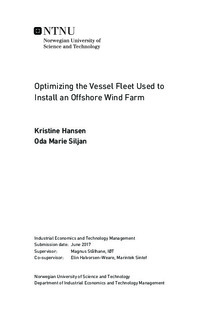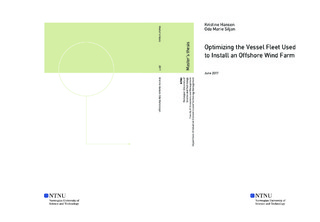| dc.description.abstract | Today, offshore wind is not a profitable source of energy compared to other energy sources. To increase the profitability of the offshore wind industry the life time costs of an offshore wind farm need to be reduced. Among others, this can be achieved by increasing the efficiency of the installation phase. Currently the vessel fleet is one of the largest cost contributors for the installation phase, and a small reduction in the vessel fleet cost can greatly improve the profitability of the offshore wind industry.
Two mathematical formulations of the fleet size and mix problem for the installation phase of an offshore wind farm are proposed: one original model and one reformulated pattern based model. The models are designed as strategic decision tools which is run years in advance of the actual installation in order to support the decision maker with valuable insight. The two models consider a given weather data and suggest which vessels to charter, the charter period for each vessel, and their respective installation schedules. The objective is to find the cost optimal fleet for the installation phase of an offshore wind farm. The models are solved with exact solution methods. To solve the pattern based model we propose three pattern generation methods. One exact method where all feasible patterns are generated, and two heuristic methods where only subsets of the most promising patterns are generated.
The proposed mathematical models are tested on several test instances. Due to the complexity of the problem the original model is not sufficient to solve test instances of realistic size. The pattern based model performs much better, and testing show that the model is able to solve test instances with five to ten vessels and 30-110 turbines, which is considered realistic. To further improve the solutions, different improvement measures are implemented. The computational tests show that the performance of the pattern based model is improved by restricting the start times, adding symmetry breaking inequalities, guiding the Branch and Bound search, and heuristically generate patterns. Heuristic pattern generation combined with restricting start times yields near optimal solutions with a great improvement in CPU time. | |

